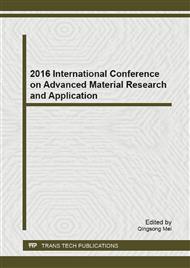[1]
Y.C. Li, M.E. Sumner, W.P. Miller, A.K. Alva, Mechanism of silicon induced alleviation of aluminum phytotoxicity, Journal of Plant Nutrition., 19(7) (1996) 1075-1087.
DOI: 10.1080/01904169609365181
Google Scholar
[2]
T. Hara, M. H. Gu, H. Koyama, Ameliorative effect of silicon on aluminum injury on the rice plant, Soil Sci. Plant Nutr., 45(4) (1999) 929-936.
DOI: 10.1080/00380768.1999.10414342
Google Scholar
[3]
R.Y. Li, J.L. Stroud, J.F. Ma, S.P. McGrath, F.J. Zhao, Mitigation of arsenic accumulation in rice with water management and silicon fertilization, Environ. Sci. Tech, 43 (2009) 37783783.
DOI: 10.1021/es803643v
Google Scholar
[4]
Y.C. Liang, J.W.C. Wong, L. Wei. Silicon-mediated enhancement of cadmium tolerance in maize (Zea mays L. ) grown in cadmium contaminated soil, Chemosphere, 4 (2005) 475-484.
DOI: 10.1016/j.chemosphere.2004.09.034
Google Scholar
[5]
A. Song, Z.J. Li, J. Zhang, G.F. Xue, F.L. Fan, Y.C. Liang, Silicon-enhanced resistance to cadmium toxicity in Brassica chinensis L. is attributed to Si-suppressed cadmium uptake and transport and Si-enhanced antioxidant defense capacity, J. Hazard. Mater, 127(1) (2009).
DOI: 10.1016/j.jhazmat.2009.06.143
Google Scholar
[6]
Y.C. Liang, Effects of silicon on enzyme activity, and sodium, potassium and calcium concentration in barley under salt stress, Plant and soil, 209 (1999) 217-224.
Google Scholar
[7]
J.F. Ma, N. Yamaji, Silicon uptake and accumulation in higher plants, Trends in Plant Sci., 11(8) (2006) 392397.
Google Scholar
[8]
E. Lombi, F.J. Zhao, G. Wieshammer, G. Zhang, and S. P. McGrath, In situ fixation of metals in soils using bauxite residue: Biological effects, Environ. Pollut. 118 (2002) 445-452.
DOI: 10.1016/s0269-7491(01)00295-0
Google Scholar
[9]
A.F. Bertocchi,M. Ghiani, R. Peretti, A. Zucca, Red mud and fly ash for remediation of mine sites contaminated with As, Cd, Cu, Pb and Zn, J. Hazard. Mater. 134 (2006) 112119.
DOI: 10.1016/j.jhazmat.2005.10.043
Google Scholar
[10]
C. W. Gray , S. J. Dunham , P. G. Dennis , F. J. Zhao and S. P. McGrath, Field evaluation of in situ remediation of a heavy metal contaminated soil using lime and red-mud, Environ. Pollut. 142 (2006) 530-539.
DOI: 10.1016/j.envpol.2005.10.017
Google Scholar
[11]
X. Li, K. Huang, H. Zhu, Dissolution kinetics of silicon from sintering red mud in pure water, Light Metals 2011, 237-240.
DOI: 10.1002/9781118061992.ch42
Google Scholar
[12]
J.Y. Ahn, S.H. Kang, K.Y. Hwang, H.S. Kim, J.G. Kim, H. Song, I. Hwang, Evaluation of phosphate fertilizers and red mud in reducing plant availability of Cd, Pb, and Zn in mine tailings, Envir. Earth Sci., 74(3) (2015) 2659-2668.
DOI: 10.1007/s12665-015-4286-x
Google Scholar
[13]
M.T. PardoM.E. Guadalix, Phosphate sorption in allophanic soils and release of sulphate, silicate and hydroxyl, J. Soil Sci., 41(4) (1990) 607612.
DOI: 10.1111/j.1365-2389.1990.tb00230.x
Google Scholar
[14]
H.L. Luo, S.S. Huang, L. Luo, G.Y. Wu, Y. Liu, Modified granulation of red mud by weak gelling and its application to stabilization of Pb, J. Hazard. Mater. 227228 (2012) 265273.
DOI: 10.1016/j.jhazmat.2012.05.046
Google Scholar


